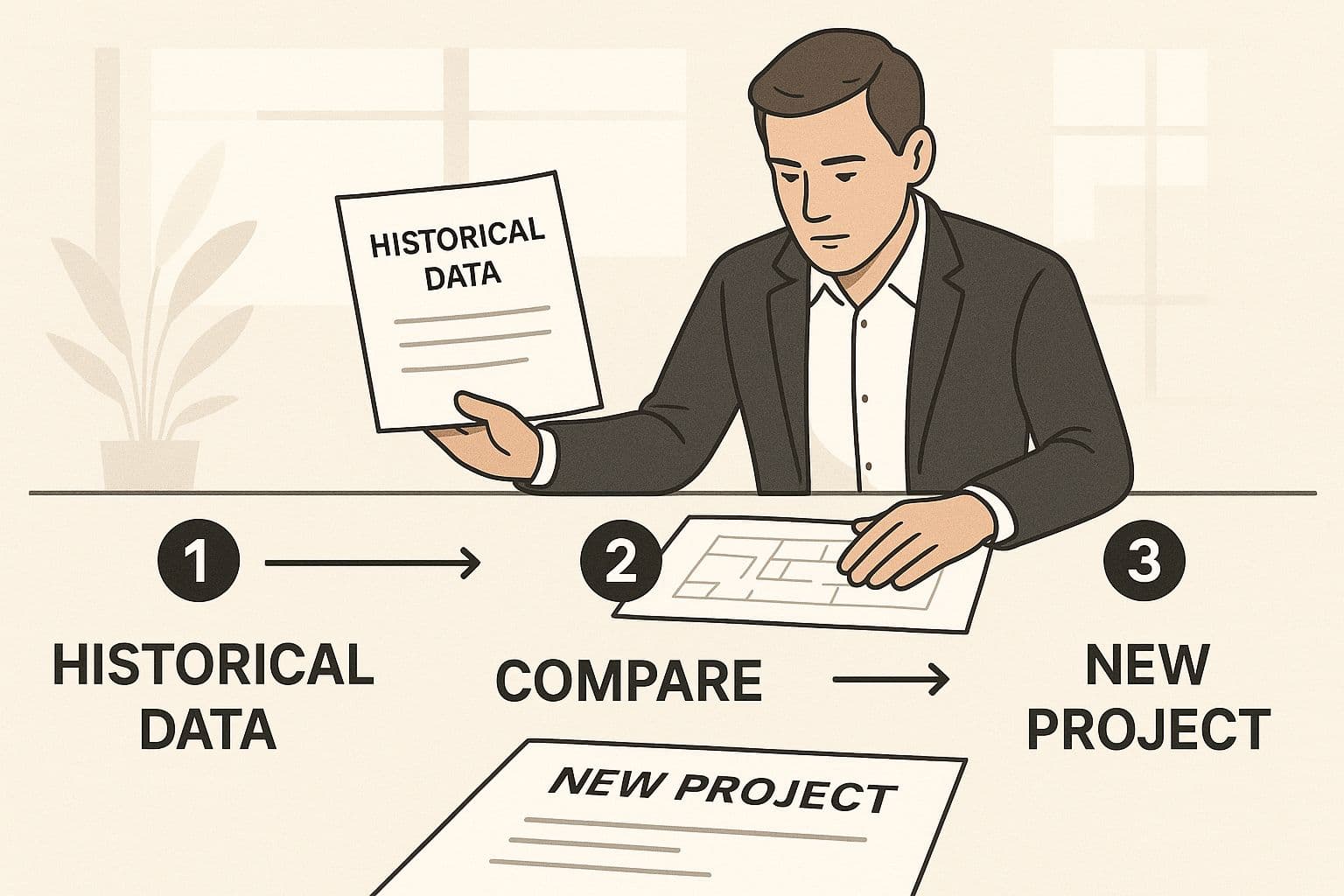Analogous estimating combines historical project results and expert judgment to produce fast, defensible ROM cost and schedule estimates. It’s ideal during project initiation or concept development when requirements are limited and you need a quick, evidence-based ballpark to decide whether to pursue a project. This top-down approach swaps some precision for speed, helping stakeholders and portfolio teams prioritize which efforts deserve deeper analysis.1
September 6, 2025 (1mo ago) — last updated October 21, 2025 (5d ago)
Analogous Estimating: Fast ROM Cost & Schedule
Use historical projects and expert judgment to produce fast, defensible ROM cost and schedule estimates for early-stage decisions.
← Back to blog
Analogous Estimating: Fast ROM Cost & Schedule
Summary
Use historical projects and expert judgment to produce fast, defensible ROM cost and schedule estimates for early-stage decisions.
Introduction
Analogous estimating combines historical project results and expert judgment to produce fast, defensible ROM cost and schedule estimates. It’s ideal during project initiation or concept development when requirements are limited and you need a quick, evidence-based ballpark to decide whether to pursue a project. This top-down approach swaps some precision for speed, helping stakeholders and portfolio teams prioritize which efforts deserve deeper analysis.1
What is Analogous Estimating?
Analogous estimating is a top-down method. Instead of summing every task, you start with the total cost or duration of a similar completed project and adjust for meaningful differences. It’s an experience-based shortcut that produces a useful ballpark when full requirements aren’t available. Use it to get a defensible early view rather than a procurement-ready number.2
“Analogous estimating combines historical data and expert judgment to create speedy, high-level forecasts, perfect for early feasibility checks and ROM estimates.”

When to Use It
Use analogous estimating during project initiation, concept development, or any early feasibility review when you need:
- A fast yes/no on whether to pursue the project further
- High-level budgeting to support portfolio decisions
- A defensible ROM to compare candidate projects
Example: If a contractor built a 2,000 sq ft house last year, that project’s final cost can be a baseline for a similar new build after you adjust for material price changes, design differences, and labor availability. Track price indexes for materials and labor when making adjustments to avoid outdated comparisons.3
Quick Comparison
| Attribute | Expectation |
|---|---|
| Speed | Very fast — hours to a few days for a ROM |
| Cost | Low — uses existing records and expert time |
| Accuracy | Lower than bottom-up; depends on how closely projects match |
| Data needs | Historical projects with similar scope |
| Best use | Early feasibility, portfolio screening, rough budgeting |
| Approach | Top-down whole-project comparison |
| Risk | Subjective bias, outdated comparisons |
Step-by-Step: How to Do Analogous Estimating
Follow these practical steps to convert past projects into a reliable ROM estimate.
1. Find similar historical projects
Search archives for completed projects that match scope, complexity, team size, and technology. The closer the match, the more reliable the estimate.
Key attributes to compare:
- Scope and complexity (feature count, integrations)
- Team size and experience
- Technology, tools, and third-party dependencies
- Regional costs (labor, materials)
2. Document and quantify differences
No two projects are identical. List differences — new features, material changes, regulatory updates, or market-driven price shifts. Translate each difference into a percentage or fixed adjustment, for example, add 20% for a new payment gateway integration.
Always record assumptions so stakeholders can see how you moved from historical data to the new forecast.
3. Validate with expert judgment
Review adjusted numbers with senior team members. Experts often spot subtle factors the raw data misses, such as a learning curve for a new tech stack or local permitting delays.
Group reviews reduce bias and make the estimate more defensible.
4. Use multiple comparables
Relying on a single past project increases risk. Use several reference projects or mix-and-match components — for example, foundation costs from one project and finishes from another — to smooth out outliers.
5. Revisit and refine
Update the ROM as new information arrives. Move to parametric or bottom-up estimating when the scope is defined and you need procurement-level accuracy. The goal is to progress from a defensible ballpark to a detailed plan as certainty improves.2
Practical Examples and Tools
Analogous estimating scales well when supported by tools that draw on many projects at once. Relevant tools include:
- Construction Material Cost Predictor
- Business Valuation Estimator
- Agriculture Yield Profit Estimator
- Manufacturing Production Time Estimator
These tools use larger data sets to improve baseline accuracy and reduce reliance on memory.
Strengths
- Fast ROM estimates help teams make early go/no-go decisions
- Low effort: no need to break down every task, saving planning time and resources
- Easy to explain to non-technical stakeholders because the method is intuitive
Industry guidance notes that analogous and other high-level methods significantly reduce initial estimating time compared with full bottom-up analyses, letting teams focus on initiatives that pass the initial feasibility screen.1
Limitations and How to Mitigate Them
Main pitfalls are data relevance and human bias. Reduce risk by:
- Using multiple reference projects to avoid outliers
- Documenting assumptions and adjustments clearly
- Running group reviews to limit individual optimism or pessimism
- Updating baselines to reflect current market conditions, such as material prices and labor rates
If historical data is old or sparse, supplement it with one of the data-driven tools listed above to get a more objective baseline.
Frequently Asked Questions
When should I switch from analogous to a detailed method?
Start with analogous estimating during initiation. Move to parametric or bottom-up estimating once scope and requirements are defined and you need higher accuracy for execution and procurement.2
How does analogous differ from parametric estimating?
- Analogous compares whole projects, using top-down judgment.
- Parametric uses unit rates, for example dollars per square foot, multiplied by quantities for greater accuracy when unit data is reliable.
What if I don’t have a single close match?
Combine partial matches: take foundation costs from one project, framing from another, and finishes from a third. Use specialized tools to fill gaps where internal records are weak.
Internal Linking Opportunities
Link to these tools and related posts to keep users engaged and improve internal SEO:
- Construction Material Cost Predictor
- Square Footage Cost Estimator
- Business Valuation Estimator
- Manufacturing Production Time Estimator
- Agriculture Yield Profit Estimator
Suggested internal links from other site pages: ROM estimates, feasibility studies, procurement planning, budgeting templates, and case studies that reference historical projects.
Final Tips
- Always document your reference projects and adjustments
- Use several comparables to reduce the influence of outliers
- Revisit and update estimates as new information becomes available
Analogous estimating isn’t meant to replace detailed planning. But when you need a fast, defensible snapshot for early decisions, it’s one of the most practical tools in your toolkit.
Want to move from a good guess to a data-backed decision? Try the Construction Material Cost Predictor or the Business Valuation Estimator above to see how historical data can sharpen your early-stage estimates.
Quick Q&A
Q: How accurate are analogous ROM estimates?
A: They’re less accurate than bottom-up or parametric methods, but can be highly useful when scope is vague. Use multiple comparables and document assumptions to improve reliability.
Q: How do I adjust for market changes or inflation?
A: Apply regional cost adjustments and index-based updates such as material price indexes. Track those indexes when updating older comparables.3
Q: What makes an analogous estimate defensible?
A: Clear documentation of reference projects, quantified adjustments, and validation by experienced reviewers make an estimate defensible.
Footnotes
-
Project Management Institute, "Practice Standards and Guidance for Project Estimating," PMI, accessed October 2024, https://www.pmi.org/pmbok-guide-standards/practice-standards.
-
U.S. Government Accountability Office, Cost Estimating and Assessment Guide: Best Practices for Developing and Managing Capital Program Costs, GAO-09-3SP (March 2009), https://www.gao.gov/assets/gao-09-3sp.pdf.
-
U.S. Bureau of Labor Statistics, Producer Price Indexes (PPI), accessed October 2024, https://www.bls.gov/ppi/.
Ready to Build Your Own Tools for Free?
Join hundreds of businesses already using custom estimation tools to increase profits and win more clients